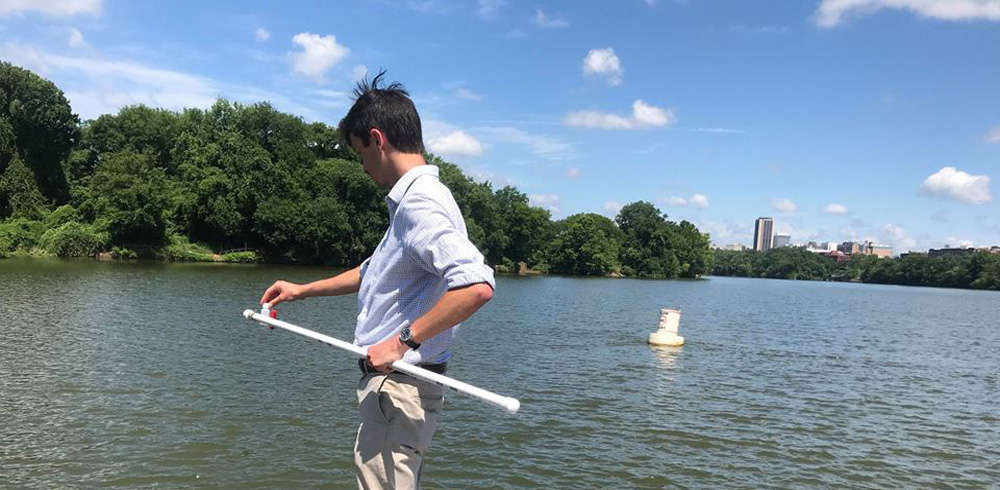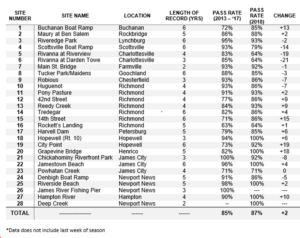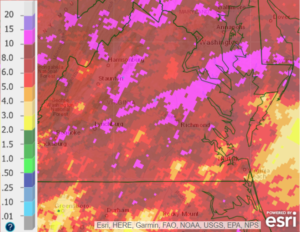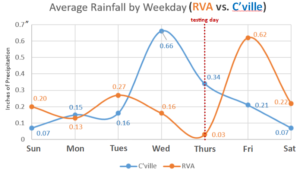It’s hard to believe another summer flown by, and another year of James River Watch is in the books. It was a successful season, with higher-than-normal rainfall and a good share of twists and turns.
Highlights and site-wise summaries are included below, but first, some serious thank-yous are in order. This program – designed to communicate river conditions to interested Virginians across the James River basin – is an effort that is wholly supported and sustained by the help of our volunteers. These generous, patient folks loaned us their time and effort all summer long, and we can’t thank them enough! In total, 62 water quality monitors donated 874 hours of their valuable time. Collectively, they generated over 375 bacteria measurements at 28 sites this summer. Amazing work! Go, you guys!
Before we dive into their hard-earned data, here’s our thesis statement: if there’s one takeaway, it’s that the James River and its tributaries are almost always safe places to swim. Among some circles, our river’s polluted past carries a lingering reputation, but the James’s health has vastly improved from previous generations. It’s true that bacteria levels are typically elevated immediately following a local downpour, but if there hasn’t been a recent rainfall, then grab some friends, visit your local outfitter, tell your grandma it’ll be alright, and get in the water! All clear? Then our results are as follows:
A Virginia summer isn’t complete without a little meteorological mayhem, and this summer didn’t disappoint. But despite this summer’s rain, our overall passing rate was 2% higher than average, at 87%! This comes as good news, and underscores the fact that the timing of heavy rainfall, rather than absolute long-term amounts, is the most critical factor in determining bacteria levels. So why did sites on the Rivanna, for example, have a tough year, while sites around Richmond fared generally well? To answer these questions, let’s take a closer look…
We’ll start with the big picture. Across the board, we’ve had a very wet summer, even record-setting by some measures. Rounds of heavy rain in late May washed out countless Memorial Day cookouts. Statewide, large parts of the watershed saw more than 10” of rain in May alone (pink swaths in the figure at left). June, July, and August weren’t quite as soaking – at least not across the entire state – but precipitation has still run roughly 50 to 100% above normal.
Heavy, localized downpours are where this summer stands apart. Many Mid-Atlantic cities have been struck by flash floods this year, including Charlottesville, Richmond, and Lynchburg in our watershed alone. (As a quick aside and nod to the inconvenient truths of climate change, these events are expected to become more common in the future.)
The following numbers are based on a period from May 20, the first week of our monitoring season, to August 29, the day I’m writing this (let’s assume neither location picks up more rainfall before midnight). Over this time, Richmond totaled 23.48” of rain to Charlottesville’s 23.85”. Now recall that, by necessity, our bacteria testing happens on Thursday. Crazy weather has a bigger effect on our results if it happens on a Wednesday, the day before, rather than a Friday, when streams have nearly a week to return to background conditions. Now take a glance at the graph below. Despite similar totals, Charlottesville and the Rivanna watersheed crushed the midweek rain game, while Richmond’s totals were bumped by a colossal 7” rainfall on Friday, June 22 (including 4.64” in 1 hour and 1.17” in five minutes!)
Richmond’s June 22nd rainfall was a remarkable event… but it had no impact on our data from June 21st. It’s safe to say that in Albemarle County and along the Rivanna, lower-than-average passing rates are the result of a rainy summer driven by midweek storms. In Richmond, better-than-expected passing rates are the result of a rainy summer negated by some fortunate timing. Similarly, the timing of heavy rains in parts of the Tidewater this summer has been lucky from the standpoint of testing. The Charlottesville vs. Richmond breakdown may be a specific example, but it illustrates a general and oft-repeated theme of ours that holds true statewide: the James River really is almost always safe to swim, but like a lot of things, it all comes down to timing, and it pays to know before you go.
If you have any questions about the numbers above or are curious about how these analyses look for an area near you, send me an email at bwatson@jrava.org! Chances are I’m curious too. I speak for myself when I say that these numbers are lots of fun to crunch. I speak for all of us when I say, once again, that we owe quite a bit to the hard work of our volunteers. For those of you still reading, thank you for your time, thank you for another successful year, and thank you for the good that you all do.




